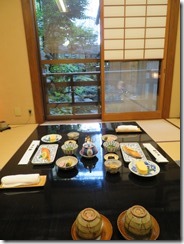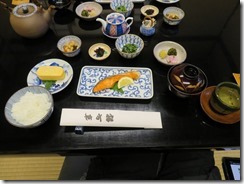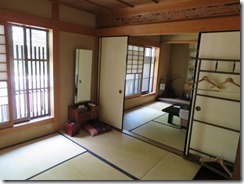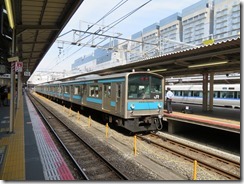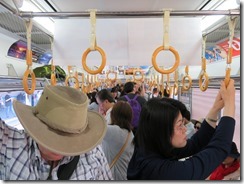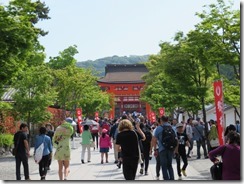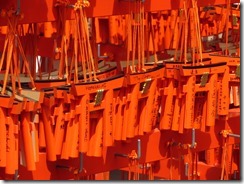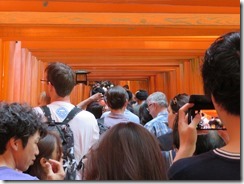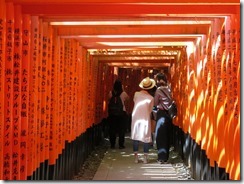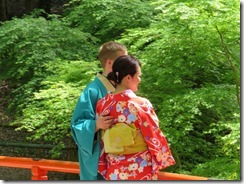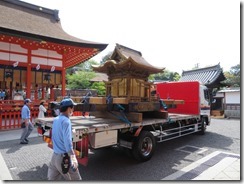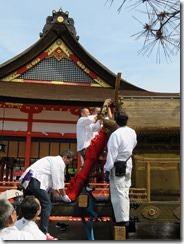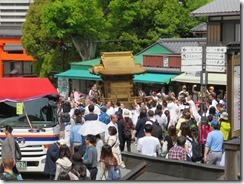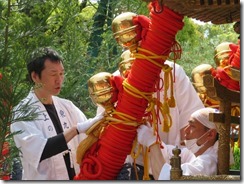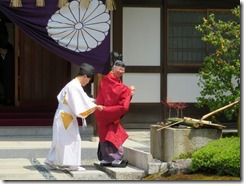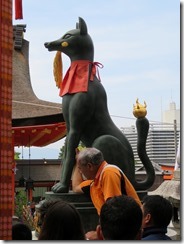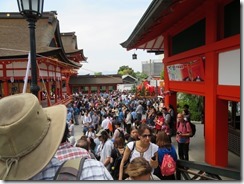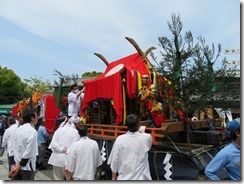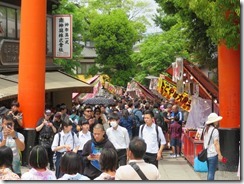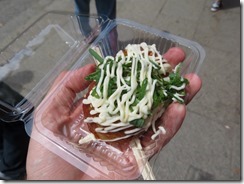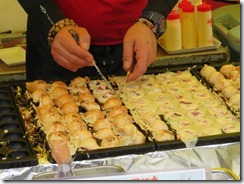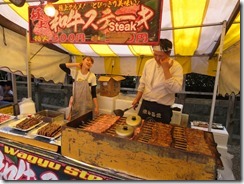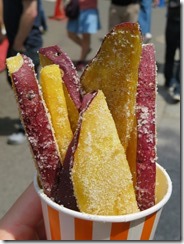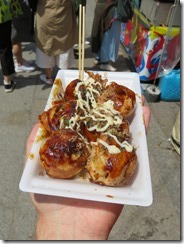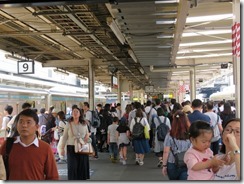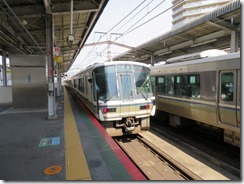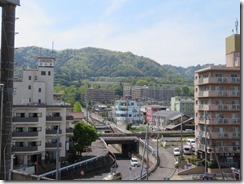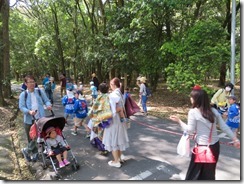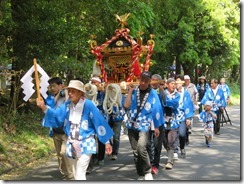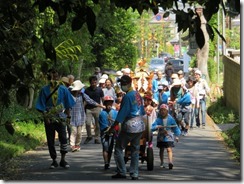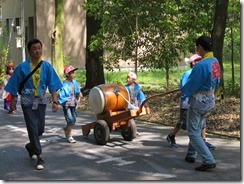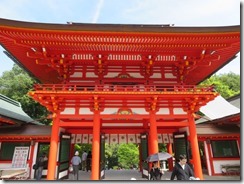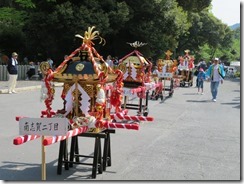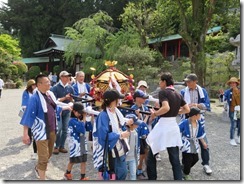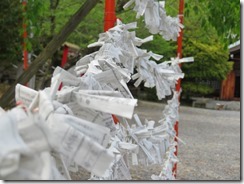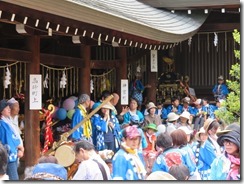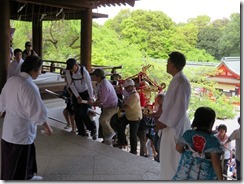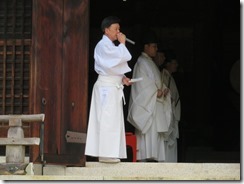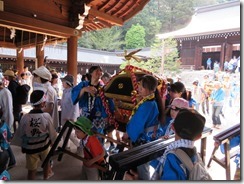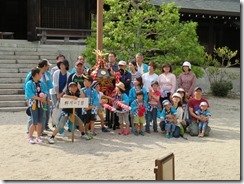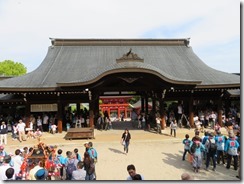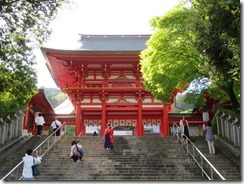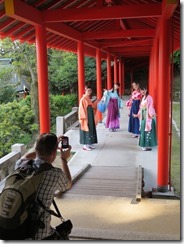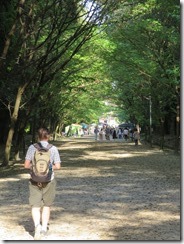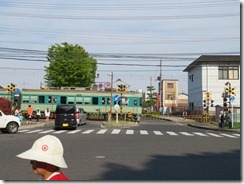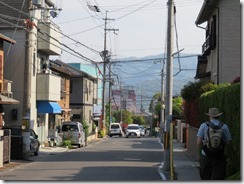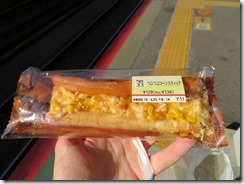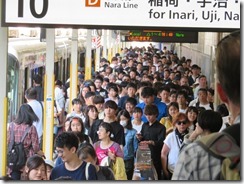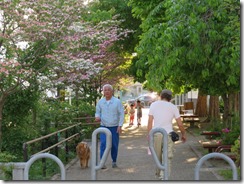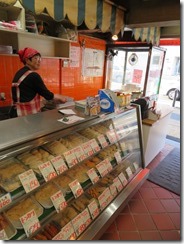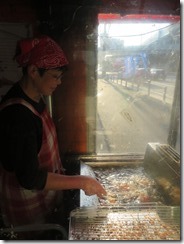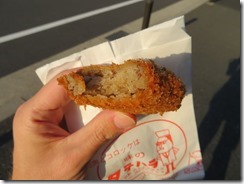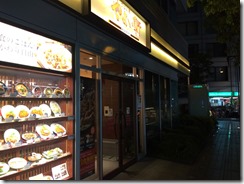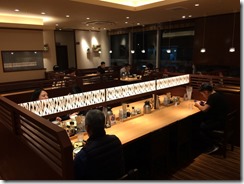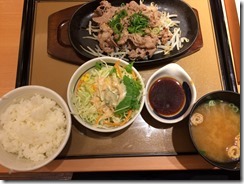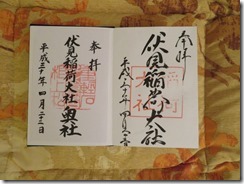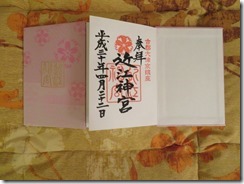Yeah, I wound up having basically the same meal again. Whoops.
I’ve done yesterday’s photos, but it’s almost gotten too late to do today’s. I really gotta get caught up on sleep…
The iPhone weather app is almost annoyingly accurate at predicting the weather over here, especially when it’s near enough to get the hour-to-hour breakdown. Annoying because it’s starting to get smug about it, but also because it’s predicting rain on Tuesday and Wednesday. Today’s weather has been unseasonably warm – they’ve even been talking about it on the news.
Opened with breakfast in the hotel. Some fairly similar stuff to yesterday, though the main dish was salmon.
After breakfast, we sadly packed out suitcases and checked out of the ryokan, and they presented us with gifts of wash cloths branded with the ryokan’s name. It was quite a nice place to stay, despite the expense (and despite the fact that our suitcases had to live in our room’s little lobby rather than on the tatami mats. We dragged our luggage to the station and stuffed them in coin lockers – I’ve been saving my 100-yen coins just for this.
Today’s plans have probably changed the most over the course of working out this trip. My original idea was that we’d walk the Philosopher’s Walk, a nice walk along a river in north-east Kyoto. When it turned out we could only stay in the ryokan for two nights, I changed instead to riding the Sagano Scenic Railway in Kyoto’s west, since we could get there from Kyoto Station with a single train.
Late in the planning, though, I discovered something new: Fushimi Inari Taisha (which we visited on our first trip in 2010) would be having the Shinko Festival today. Falling always on the Sunday nearest April 20th, the Shinko Festival is the most important festival in Fushimi Inari’s calendar, when all the portable Inari shrines get taken from Fushimi to a place near Kyoto Station in order to confer blessings on the area (its companion festival, when all the shrines come back, is the Kanko Festival, which falls on May 3rd this year).
And conveniently, Fushimi Inari Taisha is also a single train ride from Kyoto Station, so we hopped on the train and found it absolutely packed. A great many foreigners too. Not sure how many were going because they were heading to see the Shinko Festival, and how many were going simply because Fushimi Inari is a popular tourist attraction, but there were a lot of people either way.
The festival was due to start at 11, so we were aiming to be there around 10 to look around a bit before it started. It was still quite nice, but far more crowded than our last trip. We headed up the 1000-Torii Path to the first inner shrine, then headed back down the other side back to the main shrine, and when we got back, the festival was just getting underway.
I’d been under the impression that the festival would start with the parade of the portable shrines, but that wouldn’t be until 2pm – the 11am start involved the priests conferring blessings, transferring sacred objects to the portable shrines, and otherwise getting things ready. The ceremony consisted of chanting, reading of sutras, and much presenting of elaborately prepared trays of sake and mochi, fruits, vegetables, fish, and birds.
Sadly, we weren’t permitted to photograph any of this (the illustrative images here are from earlier setup steps), so we just stood and watched. Later we realised that if we headed to the front of the shrine and took photos across the stage (long-distance, like some kind of paparazzi) noone could see us do it. After an hour or so of watching that, we decided to head on – I’d been hoping they would carry the portable shrines by hand, but instead they were setting them up on trucks, so not really all that worth waiting until 2pm for.
As we turned back to the station, we spotted a side street with all the festival food booths I’d been hoping to find. Places selling stuff on sticks, yakisoba, shaved ice, roast chestnuts, and many other things. We decided to get rice balls wrapped in meat, shared a cup of satsuma sweet potato hot chips covered thickly in what we’d originally thought was salt, but actually turned out to be sugar), and shared a tray of takoyaki.
Then we headed back to the station to change to a train heading over to Otsu in Shiga Prefecture, because it was time to revisit Omi Jingu. Because, see, Omi Jingu also had a festival today.
I first became interested in this shrine when I saw it in a movie I watched named Chihayafuru, about a school club playing competitive karuta – karuta is a Japanese card-finding game, where a reader reads out the first half of a tanka poem, and two players try to be the first to grab the card from the ones laid out on the floor that contains the corresponding second-half. Omi Jingu is where the national karuta championships is held every year – in January for all-comers, and in July for high-school players. But aside from that (and obviously it’s not January or July) the shrine just plain looks pretty.
Today’s festival is the Omi Matsuri, always held the first Sunday after April 20th, and it starts at 2pm, making it fairly simple to attend both this and the festival at Fushimi Inari. As we arrived in the park around the shrine’s main approach road, we ran across a small group of kids (with adults chaperoning) towing a small portable shrine with cries of “wasshoi, wasshoi!” (something like “heave ho, heave ho!”) As we went to move on, another group went by, then another.
We decided to break away and zip up to where they were heading, and we found a whole bunch of groups and their portable shrines congregating in front of the shrine gate. Seems like it was a major event for the local community, with each district there with their own portable shrine. They were all taken up into the inner courtyard, and arranged along the walkways around the side.
Then the priests lead a ceremony of blessing, and the portable shrines were taken back outside (after the groups had taken the time to pose for a group photo with the official photographers). James and I had a close look at the hall at the back of the courtyard (not the shrine’s innermost hall, which we could see up the stairs at the back of the hall), until shrine attendants started putting up fences to block access into the inner courtyard – seems we could only access it because there was a festival on, so I feel at least a little bit privileged.
Most noticeably, and in a huge contrast to Fushimi Inari, we were quite literally the only Caucasians in the whole place. Possibly because pretty much everyone else there was either a participant or a relative.
We decided to call it a day, and headed back down the main approach road, finding some stalls towards the first torii gate – mostly stalls selling hand-made items rather than the usual festival stalls, though there were a few stalls selling things like crepes and pancakes and tapioca drinks.
Back at the station, I grabbed a “corn stick” from the 7-Eleven to snack on, then we hopped back on the train. Arriving back in Kyoto Station, I remembered there was a well-reviewed croquette shop nearby that I’d been wanting to try. Well, I say “croquette shop”, but actually it’s a butcher’s – in Japan, butcher’s shops sell croquettes.
The croquettes were sitting uncooked in a case, and when we ordered them, the woman fried them up fresh for us. Like the woman at the stall yesterday, she was also impressed at my Japanese ability. The croquettes were quite tasty, and very crunchy.
We retrieved our luggage from the lockers, then went to queue for shinkansen tickets to our next destination, but the queue was so long I was worried we’d wind up waiting forever in line for tickets, then another forever on the platform, since we’d miss the last shinkansen in a while if we waited in line too much longer. So we decided to just catch the regular commuter express. Unfortunately, it was absolutely packed.
Occurred to us too late to consider it, but we could have (a) booked our tickets at the ticket window inside the station, which had a much shorter queue, or (b) just taken the non-reserve seating car on the shinkansen (though to be fair, not all shinkansen have them). In any case, we arrived safely at our next destination, Shin-Osaka, though we had to stand the entire way.
After checking into our hotel – another Toyoko Inn – we headed out to dinner, eventually finding a teishoku place that caught our eye. I ordered a beef yakiniku set, forgetting that I’d already eaten that before during this trip. Woe! I also forgot my camera again, so had to take photos with the phone. Bah.
Today’s photo count: Six hundred and seventy-nine, including the ones on the phone
Today’s pedometer count: 15,900 steps, for 11.3km
Today’s goshuin count: Also three – two at Fushimi Inari (main shrine and inner shrine, though sadly the latter was just a loose page) and one at Omi Jingu. Fushimi Inari filled my book, too, so I bought a new one at Omi Jingu – it’s cherry blossom pink.
Today’s stamp count: Three – Inari Station, Otsukyo Station, and Shin-Osaka Station

